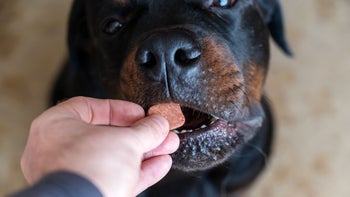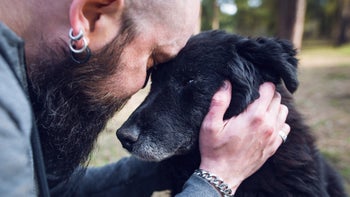
Famotidine for Dogs: How Pepcid Can Treat Stomach Ulcers
Key takeaways:
Famotidine (Pepcid) for dogs is prescribed to reduce stomach acid and protect the stomach lining.
Famotidine is available as an over-the-counter medication. But you should always give it to dogs under the supervision of a licensed veterinarian.
Famotidine can interact with medications, including other antacids. Let your veterinarian know about your dog’s medications.
Table of contents

Pepcid is the brand name for famotidine, a medication that can reduce stomach acid in people and dogs. If a veterinarian diagnoses a dog with a stomach ulcer, gastric reflux, or esophagitis, they may prescribe famotidine.
Learn how Pepcid for dogs works, how it’s used, and what the proper dosage is.
Pepcid for dogs at a glance
Common names | Famotidine (Pepcid) |
What it treats | Acidic stomach, esophagitis, gastric ulcers, gastric reflux, frequent vomiting, parvovirus |
How it comes (forms) | Tablet, capsule, oral liquid, injection |
Common side effects | None |
Average cost | $9 to $20 (20 tablets) |
What is Pepcid for dogs, and how does it work?
Pepcid is the brand name for famotidine, a medication that reduces stomach acid in dogs. It works by blocking certain proteins (histamine-2 receptors) in the stomach that trigger acid production.
Search and compare options
An oral form of famotidine is available over the counter under the brand name Pepcid. Use of Pepcid in dogs is considered off-label in the U.S.
What is Pepcid used for in dogs?
Veterinarians prescribe Pepcid to dogs to protect a dog’s stomach and esophagus from damage and reduce stomach acid. Conditions or situations that can cause irritation in a dog’s gastrointestinal (GI) tract include:
Stomach ulcers
Esophagitis or esophageal ulcers
Gastric reflux
Frequent vomiting
Gastritis
Toxin ingestion
Parvovirus
What is the dosage of Pepcid for dogs, and how is it given?
Pepcid for dogs comes in several forms, including tablets, capsules, and an oral liquid. The dosage depends on a dog’s weight. It can range from 0.5 mg to 1 mg per kilogram of body weight every 24 hours.
Sometimes veterinarians will recommend giving famotidine to a dog twice a day. Only give your dog Pepcid as prescribed by a veterinarian.
Most dogs take Pepcid without a problem. It doesn’t have a bitter taste, so it doesn’t cause drooling. Pepcid works best when given before your dog’s first meal of the day. But it can also be given with food.
Healthy heart: Here’s a rundown of the most common types of heart diseases in dogs, along with symptoms and treatment options.
Medication no-no: People take ibuprofen (Advil, Motrin) to ease aches and pains. But ibuprofen is harmful to dogs and can cause serious health problems.
Bum hip: Hip dysplasia is a common joint condition in large-breed dogs. Learn the early signs of hip dysplasia and what you can do for your dog.
There are also injectable and intravenous (IV) forms of famotidine available for dogs. These forms of the medication are typically used in veterinary settings.
Do not give Pepcid AC or Pepcid Complete to a dog. These formulations are made for humans and contain other active ingredients that aren’t safe for dogs.
What are the common side effects of Pepcid in dogs?
Pepcid is considered safe for dogs when given orally at the correct dosage. This means most dogs won’t have side effects while taking famotidine.
What are the most serious risks of Pepcid for dogs?
Dogs taking famotidine may face serious risks in certain situations. For instance, your dog could have an allergic reaction to the medication. An allergic reaction in dogs can lead to symptoms like:
Swollen face
Hives
Lethargy
If your dog has an allergic reaction to Pepcid, stop giving the medication. Consult a veterinarian or emergency clinic. Do not give Pepcid to a dog who is allergic to it or a dog who has had an allergic reaction to cimetidine, another stomach acid reducer.
When given rapidly in an IV, famotidine can cause a slow heart rate (bradycardia) in dogs.
Does Pepcid interact with any other medications?
Pepcid can interact with other medications your dog takes, including:
Antifungals like fluconazole or ketoconazole
Antibiotics, such as cefpodoxime and Ceftin
Dichlorphenamide
Iron supplements
Other antacids
Tell your veterinarian about medications, supplements, herbs, or vitamins you give your dog.
What should you do if your dog misses a dose of Pepcid?
If you miss giving your dog a dose of Pepcid, give the next dose as soon as you remember. Then, resume your regular dosing schedule.
If it’s close to the time when the next dose is due, skip the missed dose and give the next dose at the regular time. Never double up doses to catch up.
The bottom line
Veterinarians often prescribe famotidine (Pepcid) to dogs to reduce stomach acid, protect the stomach lining, and treat acid reflux. Most dogs have few to no side effects when taking famotidine.
Famotidine is available in several oral forms, including tablets and capsules. You can give it with or without food.
Famotidine can interact with other medications, such as antifungals and antibiotics. Let your veterinarian know about other medications or supplements your dog is taking.
Why trust our experts?



References
Brooks, W. (2024). Famotidine (Pepcid, Pepcid AC, Pepcid RPD). Veterinary Partner.
Budde, J. A., et al. (2023). Famotidine. Plumb’s Veterinary Drug Handbook, 10th Edition. Wiley-Blackwell.
Johnson, K., et al. (2017). Blackwell’s Five-Minute Veterinary Consult: Canine and Feline, 6th edition. The Canadian Veterinary Journal.
Merck Veterinary Manual. (n.d.). Antiulcerative drugs.

























